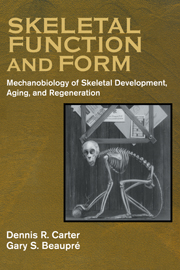Book contents
- Frontmatter
- Contents
- Preface
- Chapter 1 Form and Function
- Chapter 2 Skeletal Tissue Histomorphology and Mechanics
- Chapter 3 Cartilage Differentiation and Growth
- Chapter 4 Perichondral and Periosteal Ossification
- Chapter 5 Endochondral Growth and Ossification
- Chapter 6 Cancellous Bone
- Chapter 7 Skeletal Tissue Regeneration
- Chapter 8 Articular Cartilage Development and Destruction
- Chapter 9 Mechanobiology in Skeletal Evolution
- Chapter 10 The Physical Nature of Living Things
- Appendix A Material Characteristics
- Appendix B Structural Characteristics
- Appendix C Failure Characteristics
- Index
Chapter 5 - Endochondral Growth and Ossification
Published online by Cambridge University Press: 11 January 2010
- Frontmatter
- Contents
- Preface
- Chapter 1 Form and Function
- Chapter 2 Skeletal Tissue Histomorphology and Mechanics
- Chapter 3 Cartilage Differentiation and Growth
- Chapter 4 Perichondral and Periosteal Ossification
- Chapter 5 Endochondral Growth and Ossification
- Chapter 6 Cancellous Bone
- Chapter 7 Skeletal Tissue Regeneration
- Chapter 8 Articular Cartilage Development and Destruction
- Chapter 9 Mechanobiology in Skeletal Evolution
- Chapter 10 The Physical Nature of Living Things
- Appendix A Material Characteristics
- Appendix B Structural Characteristics
- Appendix C Failure Characteristics
- Index
Summary
Morphology and Biology
The cartilage growth that was considered in Chapter 3 is a nearly isometric growth in the relatively immature cartilage at the end of a cartilage rudiment. Most of the cartilage growth during development, however, is highly organized and directed at providing growth and ossification in specific directions. Although cartilage growth during development is generally thought of as providing an increase in bone length, complicated organized patterns of growth in various directions are observed in different regions. In the ends of long bones, in particular, three-dimensional growth patterns are observed that lead to the expanse of joint surfaces and trochanters. The directional variations in cartilage growth cause shape changes in developing bones and are responsible for the dramatic changes in skeletal appearance during development (Figures 1.9 and 1.10).
During endochondral growth and ossification, the chondrocytes undergo a characteristic process of proliferation, maturation, hypertrophy, and death. Growth is achieved by cell division, a net increase in the amount of extracellular matrix, and an increase in cell size. In the final stage of growth, the cells hypertrophy and die as the extracellular matrix calcifies. The calcified cartilage matrix is then resorbed and replaced by mineralized, well-vascularized bone tissue that is formed and maintained by bone cells. These phases of cartilage growth and ossification can be observed wherever and whenever endochondral ossification occurs. These phases can be identified in the primary growth center of the cartilage rudiment, the primary growth front of the fetal long bone, secondary growth centers, growth plates, subchondral growth fronts under articular cartilage, and healing fracture calluses (Figure 5.1).
- Type
- Chapter
- Information
- Skeletal Function and FormMechanobiology of Skeletal Development, Aging, and Regeneration, pp. 106 - 137Publisher: Cambridge University PressPrint publication year: 2000



